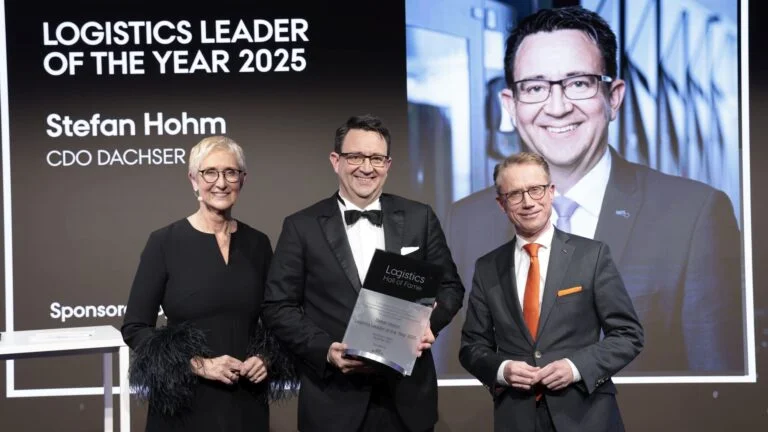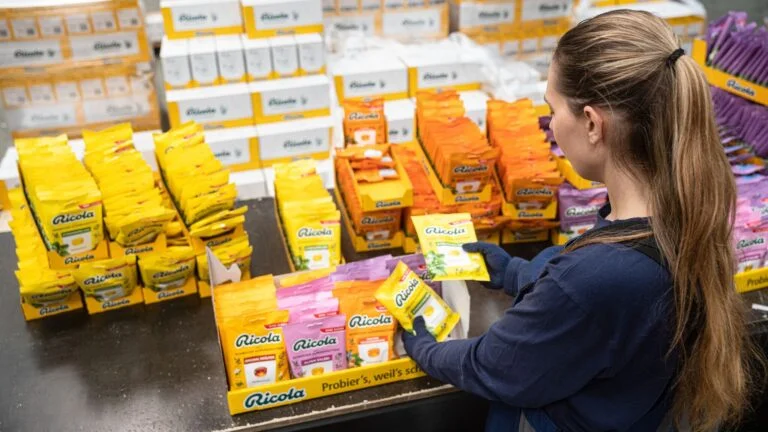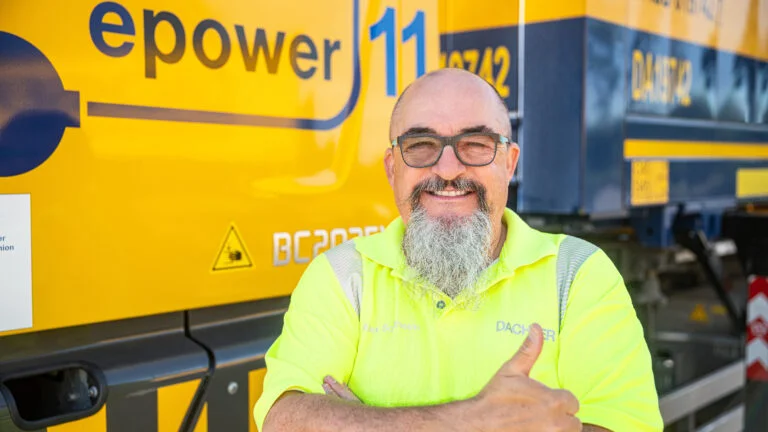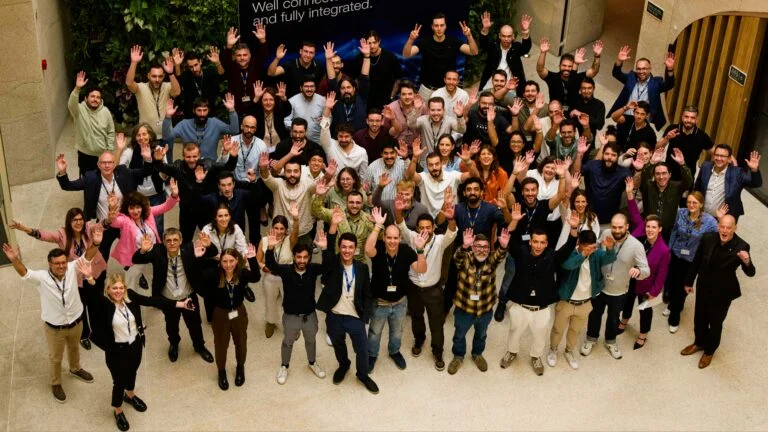Automation, robots, and more: Rethinking warehousing
By Marcus Schick I 9 minute read
02/09/2025
When the processes in and around the warehouse become too monotonous and physically demanding, the time has come for automation. In logistics today, robots, autonomous vehicles, and automated warehouses help make these repetitive processes safer and more efficient. One example is DACHSER’s Karlsruhe logistics center, where the AutoStore system revolutionizes picking and makes work noticeably easier for people.
Quick Read
You have to climb a few steps up the steel staircase to see them, though you hear their steady whirring first. At almost 6 meters above the ground, there they are: 13 yellow-and-blue robots, whizzing over a uniform grid of aluminum struts. Back and forth and to the side, they move at high speed along their own routes. They make brief stops to extend a gripper down, grab a gray container, and then take it to another part of the grid, chosen seemingly at random, where they release it back down to wherever there’s room. Is there any rhyme or reason to this?
“It’s called chaotic storage,” explains Florian Steinbrunn, Contract Logistics Manager at the Karlsruhe logistics center. He hastens to reassure us: “The robots and the warehouse management system always know exactly where each container is, so that they can transport it to the dispensing port for order processing or refilling.”
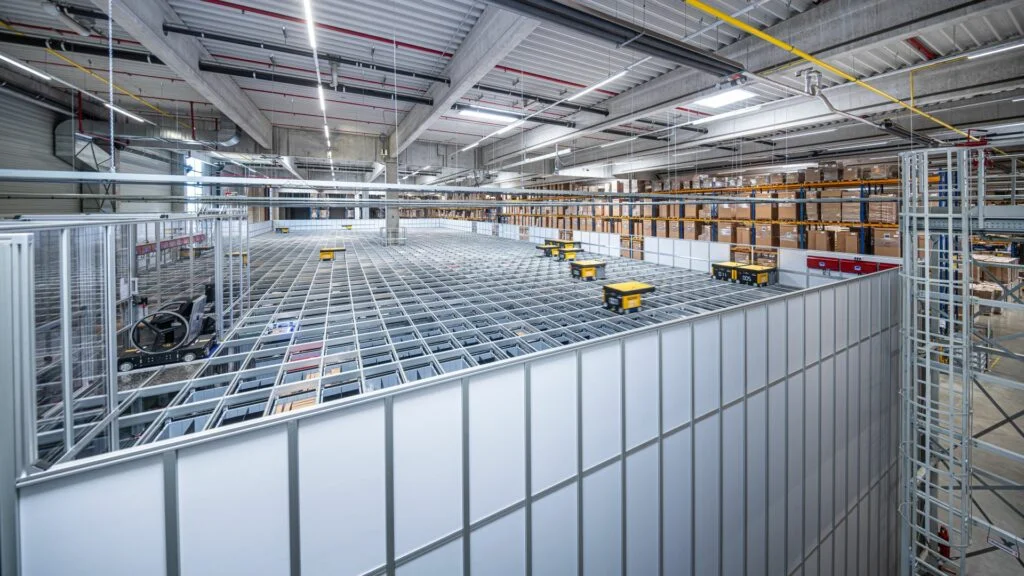
We’re in the German town of Malsch, not far from Karlsruhe, where DACHSER operates one of the most cutting-edge contract logistics locations in its network. For several months now, an AutoStore system has been picking small parts fully automatically for major customers in, say, the cosmetics industry. It consists of a grid cube—almost 40 meters long, 21 meters wide, and 5.65 meters high—that can fit 30,000 plastic containers stacked inside; each stack has 16 bins, one on top of the other. What from the outside looks like a plain, gray-sheathed block in a storage building otherwise filled with shelves is, on closer inspection, a milestone in the automation of small parts logistics.
“The speed at which the processes run and the reliability with which we can take action, even during peak loads, are impressive,” says Bernd Großmann, General Manager of DACHSER’s Karlsruhe logistics center. “For our employees, the system means a noticeable reduction in workload. Many manual tasks are no longer necessary and ergonomically challenging activities have been scaled back. The best part is that the technology doesn’t work alongside people; it works with them.”
The AutoStore solution at the Karlsruhe logistics center is the first of its kind at DACHSER and is part of the comprehensive, strategically planned automation of warehouse processes in contract logistics. Qualified personnel are becoming increasingly scarce in industrialized countries, while demands on the efficiency and quality of logistics processes are rising. That’s why DACHSER has been focusing on automation and robotics in a wide variety of fields for several years now—not as a “showroom innovation,” but as a strategic tool designed to make processes better, safer, and more robust. “The crucial question is not how much technology we can use, but which solutions can be sustainably integrated into our operational processes,” says Stefan Hohm, Chief Development Officer (CDO) at DACHSER. “Our principle is, there must always be a clear benefit for our customers and the people who work for us.”
30.000
plastic containers can fit inside the AutoStore.
The crucial question is not how much technology we can use, but which solutions can be sustainably integrated into our operational processes
In proportion: Automation in warehouse logistics
This gives the strategy behind the automation initiatives at DACHSER a clear outline: It’s not about maximum mechanization at any price, but about the ideal interplay of technology, people, and processes. “We keep a very close eye on the challenges our locations have to deal with in their day-to-day work. And we’re looking very carefully at what solutions we can use to overcome these challenges,” says Thomas Klare, Head of Corporate Contract Logistics.
The focus is on four target criteria: improving process efficiency, providing ergonomic relief for employees, safeguarding the quality of services, and ensuring the future viability of the locations. The latter is becoming increasingly important, particularly in view of the lack of qualified personnel. “Automation is not an end in itself. It helps us relieve the burden on people whose work still involves monotonous, repetitive, or physically demanding tasks,” Klare says. “This frees up employees to concentrate on more demanding tasks, such as value-added services.”
For DACHSER’s contract logistics experts, the strategic direction arises from specific needs and on-site experience. “Our roadmap is dynamic. It thrives on ideas from the branches, on what we learn during implementation, and on continuous dialog with our customers and technology partners,” says Michael Mayer, Department Head Corporate Contract Logistics Consulting at DACHSER. “The first thing we look at is always feasibility. Among other things, we examine whether an innovative technology can also be fully integrated into Mikado, our warehouse management system.” Approaches that then prove themselves in live operations are subsequently rolled out at DACHSER in the medium term. “If anything turns out to be a dead end, we reexamine it in a transparent process and try a different approach.” “
We keep a very close eye on the challenges our locations have to deal with in their day-to-day work. And we’re looking very carefully at what solutions we can use to overcome these challenges.
Future-proof contract logistics
With this goal in mind, DACHSER is working hard at many points in its network to integrate automation into existing processes in a meaningful way. The Memmingen site, for example, has been operating a fully automated high-bay warehouse since 2023, with space for 52,000 pallets of non-chilled food and food packaging. Under ideal conditions, it can handle 200 pallets of incoming goods and 200 pallets of outbound goods per hour. This is made possible by features such as automatic unloading systems, an automatic palletizing station, and eight rail-guided rack operators in high-bay storage. “The facility brings together state-of-the-art automation technology and modern sustainability concepts based on the accumulated expertise of our network and our employees,” Hohm says.
In Magdeburg, a fully automatic hood shrink system was put into operation to shrink-wrap bulky goods with a high degree of stability. Sensors measure the pallet height and automatically adjust the amount of film, and a steam-based shrink process ensures a perfect fit. The system lowers film consumption by as much as 85 percent while further reducing transport damage—a win for efficiency and sustainability.
At the Berlin-Schönefeld site, a semiautomated system supports the assembly of sales displays for large customers in food retail. Manual effort is greatly reduced: Warehouse employees continue to assemble the individual display cartons on the quarter pallets and ensure that they are loaded correctly, referring to large monitors that display the specifications as graphics. Then the system takes over: With over 120 strappings and more than 100 wrappings per hour, the display building system enables a smooth, highly standardized process with consistent quality. “This combination of human and machine has made the process not only faster but more flexible. It’s possible to handle very small batches and design changes at short notice without any loss of quality,” Mayer says.
The list of successful automation solutions at DACHSER goes on and on. It includes driverless transport systems in the warehouse, autonomous movement of transport containers, and parking spaces for loading or unloading at the transit terminal. Also on the list are research and development projects of the DACHSER Enterprise Lab in partnership with the Fraunhofer IML and Fraunhofer IAIS research institutes. Such projects serve to advance the DACHSER network, focusing on anything related to digital technologies, such as data science and artificial intelligence, real-time positioning and the 5G mobile communications standard, machine connectivity (internet of things), autonomous vehicles, adaptive warehouse systems, and much more. It ranges from autonomous driverless transport systems in warehouses to the autonomous movement of transport containers.
You can find out more about the services of DACHSER Contract Logistics on the company’s website.
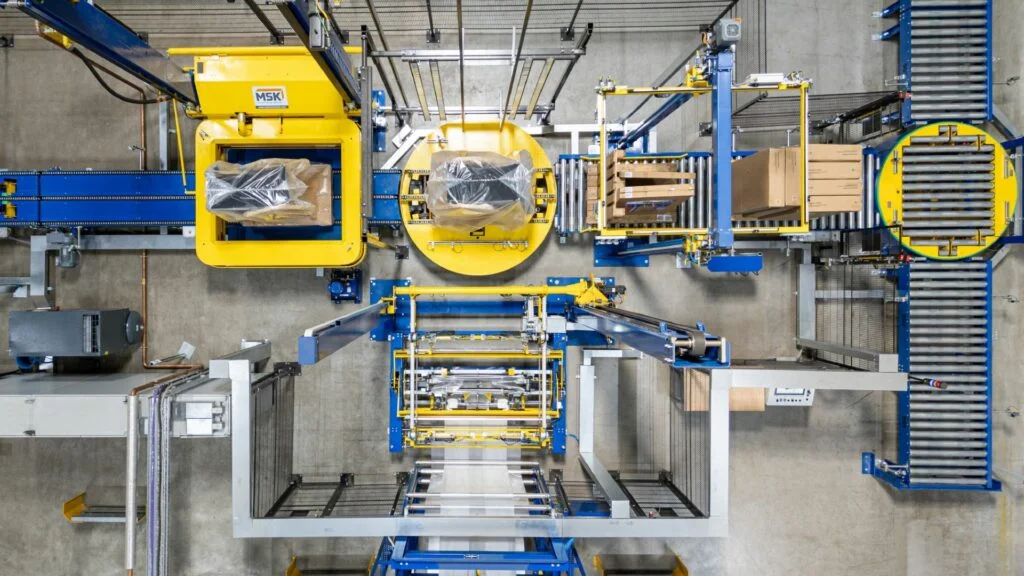
AutoStore: The game changer that makes picking easy
Back to the Karlsruhe logistics center: Mariana Ciobanu, an experienced order picker, is standing at one of four transfer stations on the “ground floor” of the AutoStore system. Using the “CarouselPort,” the system supplies her with exactly the right containers of small parts for her order by means of a box carousel. She gets help from an intuitive picking assistant above the dispensing carousel. When the boxes arrive in front of her, Ciobanu is shown what to do via visual signals. For example, right now the compartment in the box of eyeliners for a cosmetics company is illuminated and the required quantity is displayed on the monitor. If she reaches in now, the compartment lights up green; if she accidentally reaches into the wrong compartment, it turns red. A special patented technology turns the worktable into a touchscreen and guides Ciobanu step by step through each task. “I no longer have to drive down long aisles of small parts bins for picking, which is a huge relief,” she says. “This is pleasant, clean work that’s also much less prone to errors.”
At present, Ciobanu still has to pause her gathering of the many and widely different products so that she can pack the parcels ready for dispatch. General Manager Großmann says that the next stage of expansion will focus on this issue: “Another project team is currently working on automating the packing table up to the point of loading items into the parcel service provider’s loading container. This will help achieve the highest possible level of efficiency of the AutoStore system.”
For our employees, the system means a noticeable reduction in workload. Many manual tasks are no longer necessary and ergonomically challenging activities have been scaled back.
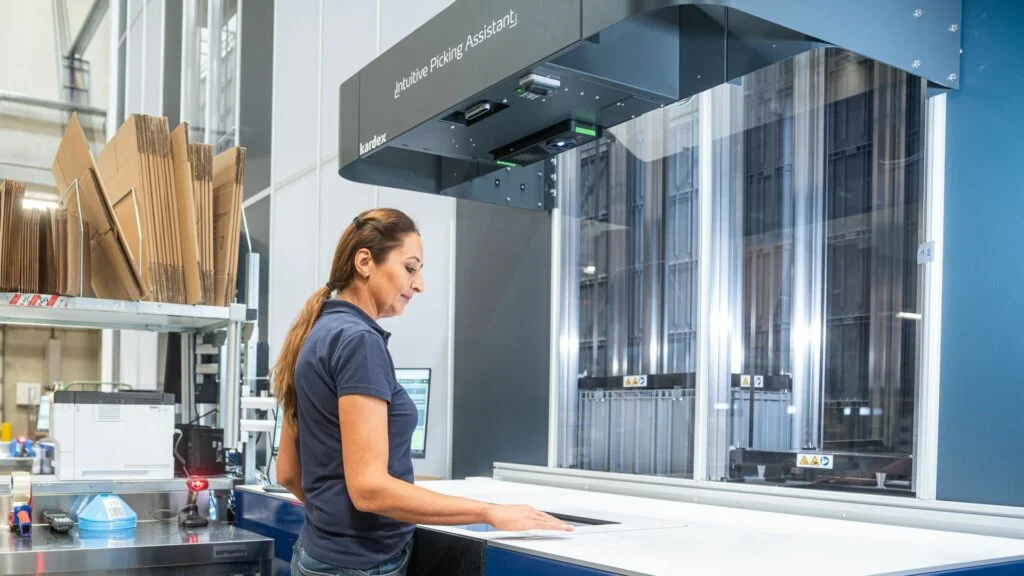
However, this needn’t be the end of automation innovation at the Karlsruhe logistics center. On the contrary: “Thanks to its modular structure, AutoStore can easily be expanded as volumes increase. This is a real game changer for us,” Steinbrunn says. “Not only because it lets us work more efficiently, but also because we can respond to fluctuations with more resilience.” The contract logistics manager is clearly enjoying “his” project: “Automation in logistics is not a sprint but a marathon.” The robots on the upper floor of the AutoStore grid are also set up with this in mind. At the end of the shift, the system shuts down and the robots dock at their charging stations. Soon they’ll be ready again to devote their full energy at any time to warehouse chaos—chaos that couldn’t be more orderly or intelligent.

